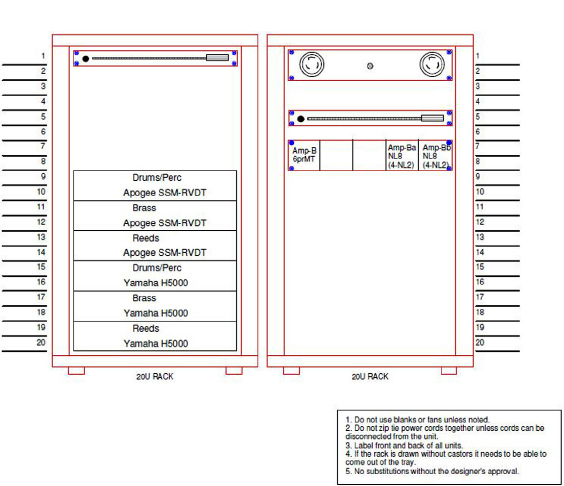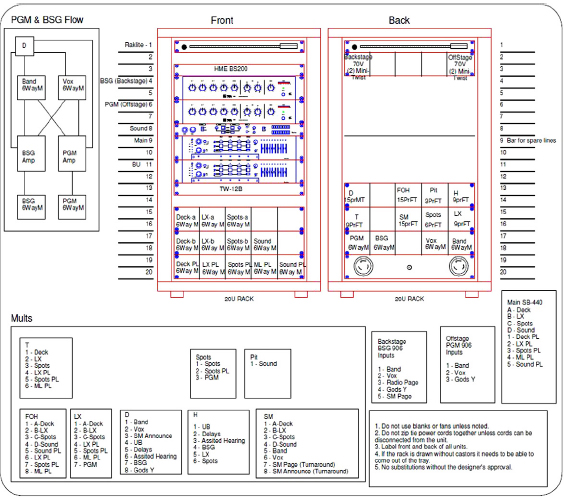MIXER’S JOB
The job of the mixer is always to fill the holes with whatever hasn’t been done and do it efficiently and without need for praise. The mixer is there to make sure the designer’s vision comes to life and to make everything feel effortless and smooth. There are mixers who pride themselves on how little the designer has to do. In the end, the less the designer has to worry about the little details, the more he or she can concentrate on the big picture. If the designer is trying to help fix intercom problems, he can’t focus on why that reverb isn’t working. When a mixer does his job right, the designer is relaxed and only has to think about the sound of the show. The mixer’s job is simply to make the system work without drawing attention to the sound department.
If a mixer is lucky he will be handed a stack of drawings when he starts on a project. This is not always the case, but for most Broadway shows this is the standard. The first thing the mixer needs to do is evaluate where the design team is and how he can help in the process. It is important to understand the team you are working with and what their strengths and weaknesses are. It could be possible to work with a brilliant designer who is just not good at system design and he will need lots of help, but it is also possible to work with a well-oiled machine of a design team that cranks out show after show and they have a system that requires very little input from the mixer. There are times when the design team will do a little and there are times when the design team will do everything. The rack drawings and cable order as well as the bundles and labels will sometimes be done by the design team. On larger shows with a well-established designer, this is definitely the case, but there are times when a lot of this will be left up to the mixer.
Figure 6.1. A typical amp rack drawing.
The first things that must be done to move beyond the broad strokes of the signal flow drawings are the rack drawings. All of the gear must be placed into racks for the show. As a mixer it is important to know about racks. There are different size racks and they are sized by spaces. A 16u rack is very common, which is a 16-space rack. Racks come with rack rails that allow equipment to be screwed into the racks. Most racks are 19″ wide and 19″ deep. There are deeper racks available for use when building some amp racks. All of the equipment for the system will need to be racked up and the drawings show how it is to be racked. Figures 6.1 and 6.2 show some examples of rack drawings.
Figure 6.2. An intercom and paging rack drawing.
A rack drawing is required for every rack in the show. Rack drawings show where the gear for the show will live and detail the plan for the sound system so that people can build the system. Rack drawings usually consist of a drawing of the front and back of the rack as well as rack space numbers. Sometimes the drawings will detail patching and wiring needs for the rack, as well as the names for the equipment and the equipment channels. The more detailed these drawings are, the better. The more information you provide your build crew, the less they will need to ask you. The fewer questions they have means more time they can work on their own while you deal with problems they haven’t gotten to yet.
As the rack drawings are done, the next level of the system starts to become clear, which is the way the system is connected, and the parts and pieces needed for the system. The supplemental equipment order for the show starts to grow as the drawings are done, which consists of the racks you need as well as the cables and mults and other minutia needed for the system. The important thing to know is that the shop will rarely bring you anything you didn’t ask for. The shops are very good at keeping track of every little item you take out of the shop. The sound shops are large companies dealing with tens of thousands of items and every item has a value. If you need something, you will have to ask for it. Never assume you will get anything. An SM58 will always come with a mic clip, but a Neumann U87 will not automatically come with the $400 shock-mount clip. It is important to do the drawings and plan out every detail of the sound system so you can give the shop a very accurate supplemental equipment order to complement what the designer has asked for.
The shops are very accustomed to getting a list from the designer that is the broad strokes of the system and includes the big-ticket items, and then later getting a list of the nuts and bolts of the system. The shop will let you know if you have over-stepped the budget if you ask them to. They understand that the mixer does not have the authority to add anything that will increase the rental price of the equipment and they will give you whatever you need as long as it does not cross that line. If it does, you will have to find a different way of working out the system or you will have to explain why this is so crucial.


